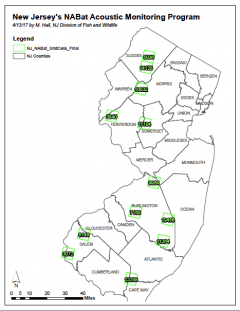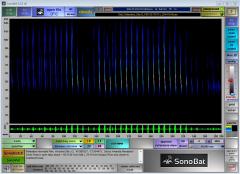Acoustic Bat Monitoring
High-tech and hands-off: New tools allow for rapid bat surveys statewide.
 Volunteer Jerry Jackson with new detector and car mount ready to conduct mobile acoustic survey.
Volunteer Jerry Jackson with new detector and car mount ready to conduct mobile acoustic survey.
Echolocation
In early 2016, in partnership with New Jersey Division of Fish & Wildlife, Conserve Wildlife Foundation developed a redesign of the previous Mobile & Stationary Acoustic project.
 Zoom+ Grid cell map of new mobile acoustic route locations.
Zoom+ Grid cell map of new mobile acoustic route locations.
Four Pettersson D500x acoustic detectors were perchased to aid in bat research across the state as part of the NABat Monitoring Program. Acoustic detectors take advantage of a key bat behavior: echolocation. As bats fly, they are constantly giving off rapid, high-frequency pulses of sound (or “calls”). The sound pulses bounce off nearby objects and return to the bats’ ears as echoes, providing them with feedback about the size, shape, distance, and trajectory of those objects. Thus bats can navigate through the forest, avoid obstacles, swoop down for a drink of water, and hunt for insects in the total darkness of night.
Acoustic Detection
For the most part, bat calls are ultrasonic – meaning they’re above the 20 kHz upper range of human hearing. So we can’t hear them, but an acoustic detector can. The Pettersson D500x is a full-spectrum ultrasound recording unit intended for long-term monitoring and recording of bat calls. Since different bat species have unique call patterns that can be used to tell them apart, acoustic technology allows you to document the diversity as well as the abundance of bats in an area of interest.
 Zoom+ Sonogram captured by Peterrsson D500x, example of Northern long-eared bat call.
Zoom+ Sonogram captured by Peterrsson D500x, example of Northern long-eared bat call.
With bats facing new and serious threats – like White-Nose Syndrome and the rise of wind turbines – there is an urgent need for bat population data. In the Northeast, most states are now including acoustic surveys in their toolkit. Detectors can be mounted on vehicles and activated while driving at night, making them a pretty quick and easy way to get a lot of information, all without having to catch, hold, or even see a single animal.
Putting Volunteers to Work
Most of our mobile acoustic surveys are now done by volunteers. Volunteers are assigned a 10-30 mile driving route in their local area to travel twice each summer after dark.
There is currently a waiting list to volunteer for this survey.
Results:
2017 Mobile Acoustic & Summer Bat Count Report - 10.3MB |
>> 2022 Mobile Acoustic Survey Report
Find Related Info: Bats





